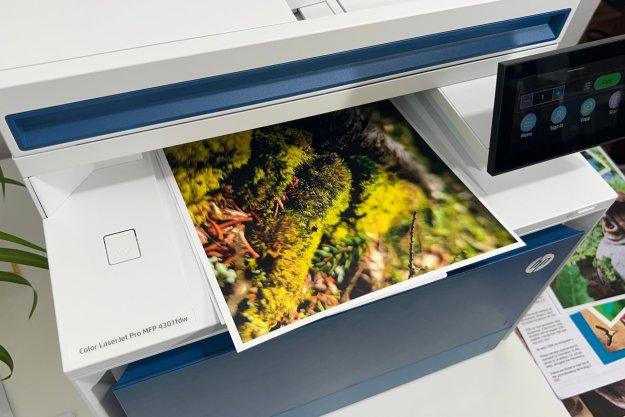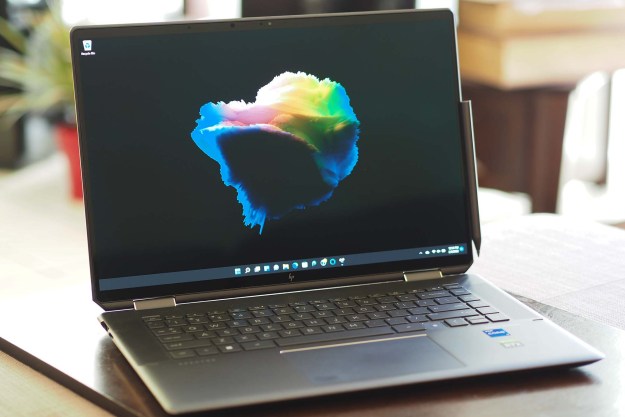- Attractive and compact case; ultra quiet; efficient; affordable; runs most games competently; quality accessories
- Very little expandability; slightly above average gaming performance
Summary
After leaving traces of drool on HP’s tiny-yet-powerful Firebird on the show floor at CES, we couldn’t wait to get (a clean) one home and put it through all the rigors of real-world gaming. The computer’s hybrid design combines components from both the powerful desktop and compact notebook realms in an attempt to wring both performance and efficiency from a compact desktop you wouldn’t be ashamed to show off. It’s a unique approach that flies in the face of the typical over-the-top gaming rigs that emphasize computational grunt above all else. But can scavenged notebook pieces really compete in a field dominated by shameless watt guzzlers? We set up our freshly acquired Firebird up in the DT labs to find out.
Features and Design
With the Firebird, HP has set out to reach for a relatively rare design aesthetic in gaming computers: understatement. Compact, low-key and solid could all be used to describe the chassis itself. In fact, if Apple set out to design a gaming desktop, it might look something like this.

Next to a normal-sized gaming system (especially Alienware’s excessive X58,) it looks downright miniature. And there’s good reason for that. Inside, things are quite a bit different. Lifting a latch hidden discretely below the front panel, swings open the left-hand panel, which easily lifts off, revealing the guts of this pony. While the motherboard, Intel Core 2 Quad 2.66GHz processor and 4GB of DDR2 RAM are all standard desktop fare, the hard drives and video cards are another matter. HP reached for two of Nvidia’s notebook-like GeForce 9800S cards in the video department, which have been tailored by Nvidia for lower power consumption and size. And the company accomplished the same goals by using dual 2.5-inch, 250GB notebook drives, rather than 3.5-inch desktop drives.

And another thing: There’s no power supply in here. HP has taken another design cue from notebooks and externalized the entire fanless, brick-like unit. With only 350 watts on tap, you’ll also note that this is also one power-efficient computer. (More typical gaming machines often require over 750 watts to feed their hungry graphics cards and processors.) A laptop-style connector feeds the Firebird through a power port on the back panel. There’s also a menagerie of other connectors back there, including six USB ports, a FireWire connector, two eSATA ports, analog inputs and outputs (plus one optical), and an Ethernet jack. For video, you’ll find both DVI and HDMI connectors, making dual displays a possibility.
Though a Mini PCI Express port will allow you some very limited upgrade potential, tweakers will be disappointed to find that they can’t replace the video cards, and there aren’t any open internal expansion slots to add cards to, either. That’s a definite caveat, but we suspect most buyers of this wrapped up, all-inclusive system won’t miss the expandability.
Accessories
Though even the classiest boutique builders are prone to outfitting their systems with cheap mice and keyboards (perhaps under the assumption that hardcore gamers will replace them with their peripherals of choice), HP has kept the quality of the Firebird’s accessories extremely high. In fact, we weren’t even tempted to replace them with the aftermarket peripherals we do have hanging around. The slim-line wireless keyboard feels solid, and the wireless mouse suffers from zero lag – both extremely important factors for gamers. Setup is also effortless: After plugging them in, there’s not much to remind you they’re wireless besides battery-life indicators in the system tray in Windows. The mouse could use a few extra buttons for hardcore FPS games, and the keyboard’s shallow keystrokes might not satisfy button mashers, but both left us happy 
Performance
Click the subtle power button on its face, and the Firebird elicits barely a whisper as the two fans next to its top-mounted radiator whir alive. Ours took a fairly reasonable minute and 15 seconds to get into Windows Vista, and another 15 seconds before all of Vista’s gadgets had loaded and a browser window would open. Nothing to write home about, but the boot times on gaming systems rarely are, and we’ve seen worse.

Fortunately, the nagging ends as soon as all these initial tasks are out of the way, because HP has taken a minimalist approach to the software load on the system. In fact, you won’t even find a single desktop icon from the company, and even HP’s update manager is presented as an option. Only a tasteful VooDoo wallpaper even lets you know where this system is from. HP does install a copy of Grisoft AVG Professional anti-virus, but as far as we’re concerned, it’s a welcome
addition.
Our system did present one particularly irksome setup woe: sound didn’t work out of the box. After double-checking our speaker system, cable connections, and looking for a hidden mute button, we only fixed it by opening the Firebird’s audio manager and clicking “Set Default Device” as a last-ditch effort. It took less than 10 minutes to hunt down the issue, but we can see less tech-savvy users finding this a huge annoyance to deal with on a system that should work flawlessly right out of the box.

In Crysis, the Firebird proved up to the task of generating lush 3D worlds, as long as we didn’t push too hard. Setting display resolution to 1920 x 1080 clearly brought it to the brink, even with all settings at medium. And when things heated up onscreen, frame rates dropped to an unacceptable level. In the end, we compromised by dropping a handful of effects down to low levels of detail, at which point the system refused to drop below 30fps, even during intense jungle firefights.
After pulling ourselves away from the actual games, we finally sat down to benchmark the Firebird for those who need some sort of numerical breakdown of performance. Running Futuremark’s 3DMark06 turned up a respectable 12,297 3DMarks, placing it a bit behind the $6,000 AVA Direct supermachine we ran through the ringer back in September, but for the money, it’s quite a score. Purebred, high-dollar gaming rigs can hit the 20,000 mark without breaking a sweat, though, so it’s clear that this is no “ultimate” rig.
Conclusion
Looking at the Firebird from a brute performance perspective, it’s far from the most powerful computer to pass through the doors here. And if you’re looking to brag about 3DMark scores or set every game to maximum settings, this one won’t cut it. But that’s missing the point of the Firebird, and overlooking several other factors that more than compensate for a few thousand 3DMarks. For starters, it’s clear that HP set out to accomplish a unique look with the Firebird, and we think they’ve pulled it off with one of the best looking gaming rigs we’ve been lucky enough to lay eyes on. Second, the unique “hybrid” build of the system makes it both extremely power-efficient and quiet. Those are two rare features that not many gaming systems can claim to offer. And finally, HP launched the Firebird 802 at $1,799, but it’s already dropped to $1,299. That astounding $500 price drop (within only months) and makes it an unbelievable bargain, even neglecting the non-performance features we just mentioned. The HP Firebird is one of the sweetest systems we have seen in years.

- Attractive, unique and compact case
- Ultra quiet
- Power efficient
- Extremely affordable
- Runs most games competently
- Quality accessories
- Great combination of price, performance and looks
Cons:
- Very little expandability
- Initial sound problems
- Slightly above average gaming performance
Editors' Recommendations
- 9 best laptops of 2024: tested and reviewed
- The best 17-inch laptop deals from HP, LG, Razer, and more
- 9 best 2-in-1 laptops in 2024: tested and reviewed
- 9 best processors for PC gaming: tested and reviewed
- Best 14-inch laptops for 2024: tested and reviewed



